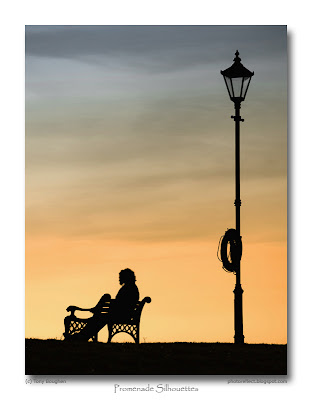 click photo to enlarge
click photo to enlargeI once posted on a photography forum an image of the silhouette of a bicycle (The bait digger's bike) propped against some old seaside railings. All the details in the shot were black, and they were set against the orange and purple glow of dusk. The comments that followed were more numerous than I expected, and quite a few were about the details of the bike, speculation about its gearing, quality and so on. What I learned from this is that the reduction in detail that a silhouette entails focuses people's attention on the details that remain to a greater extent than would have been the case if the image had been well lit.
Today's photograph is a case in point. I took it a while ago at Lytham Green, an open space next to the where the River Ribble flows into the Irish Sea at Lytham in Lancashire. It shows my favourite photographic model (my wife), sitting on one of the ornate cast iron benches next to the footpath that overlooks the water. Next to her is a street light with an old style lantern top, from which hangs a life belt and the attached rope. Apart from the grass and the late afternoon sky of February that's it. It's a shot that I don't think would work if the light had been behind me and the scene had been fully lit. I don't claim that it's a great shot, but I do think that the silhouette I captured has more interest, and that the eye lingers over the details longer, than would have been the case with any other treatment of the subject.
Of course, the Victorians knew all this, as did the eponymous Etienne de Silhouette (1709-1767), Louis XV's miserly finance minister, who discovered the power and interest of silhouettes as he spent his retirement cutting them out of out of black paper. So too did John Miers (1756-1821), the English painter, whose portrait silhouettes on plaster and card were much sought after for the likeness (!) and detail of his depictions. Perhaps, in these straitened times, when money is tighter, and people are doing more for themselves, the inexpensive art and craft of silhouette cutting will make a comeback to while away those dark winter evenings!
photograph & text (c) T. Boughen
Camera: Olympus E500
Mode: Aperture Priority
Focal Length: 96mm (192mm/35mm equiv.)
F No: f4.5
Shutter Speed: 1/2000
ISO: 100
Exposure Compensation: 0 EV
Image Stabilisation: N/A